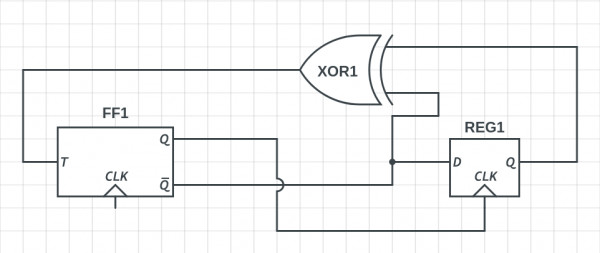
Flip flops are positive edge triggered.
T = Q1’ ⊕ Q0
D = Q1’
| Q0 |
Q1 |
Q0 (Next) |
Q1 (Next) |
D |
T |
| 0 |
0 |
1 |
1 |
1 |
1 |
| 1 |
1 |
1 |
0 |
0 |
1 |
| 1 |
0 |
1 |
0 |
1 |
0 |
| 1 |
0 |
1 |
0 |
1 |
0 |
At Time 0: Initial state (Q0 Q1) = (0, 0)
At Time 1: Since T is 1 i.e. trigger so Q1 will change its state to 0 → 1 now this change of state is given as CLK to D FF and that is +ve edge triggered so Q0 will also change its state from 0 → 1 because i/p to D FF is 1. Therefore (Q0, Q1) = (1, 1)
At time 2: Here T is 1, so state of Q1 is changed from 1 → 0 but this will act as -ve edge to D FF so Q0 will not change its state. Therefore (Q0 Q1) = (1,0)
At time 3: i/p to T FF is 0 i.e. latch so Q1 will retain its state 0 → 0, this will act as -ve level to D FF so Q0 will not change its state. Therefore (Q0 Q1) = (1,0)
Now it will stuck at (1,0)
Therefore: 00 → 11 → 10 → 10 is correct answer.